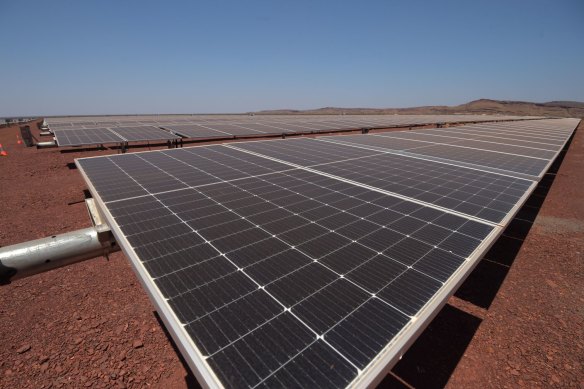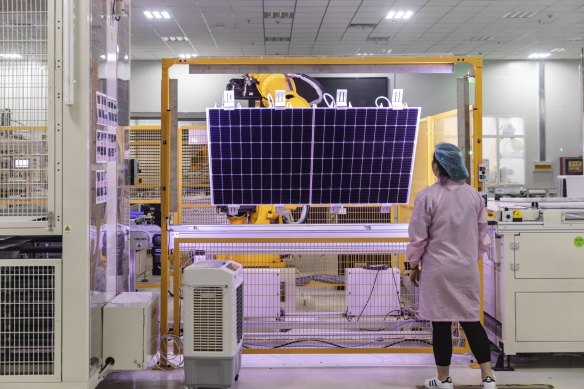This was published 7 months ago
Australia invented solar panels. Now 99 per cent of ours are made in China
By Mike Foley
Australian solar manufacturing could disappear offshore without government support, as the industry declares expensive local production costs will drive companies to cheaper jurisdictions like China while the US attempts to lure companies for its own green energy push.
The warnings come after the Albanese government launched a $1 billion Solar Sunshot scheme on Thursday to develop Australian manufacturing of solar panels and parts, offering grants and financial credits for production, with money expected to flow before the end of the year.

Australia’s nascent solar technology industry could be lost overseas without more support, the industry warns. Credit: Carla Gottgens/Bloomberg
Australian researchers created solar photovoltaic technology – which converts sunlight directly into electricity – but China invested strategically in manufacturing and now dominates global supply, producing about 90 per cent of the world’s solar panels.
There is significant growth potential in the local market, with around 99 per cent of Australia’s solar panels coming from China and 1 per cent made locally.
“We’ve created innovation and then seen all the value being added offshore,” Prime Minister Anthony Albanese said on Thursday. “We’re not going to miss the opportunities this generation.”
Australian inverter maker Selectronic has made electrical components in Melbourne for 60 years. Its chief executive Rod Scott said the company may have to send some of its production offshore to remain competitive.
Scott, also chairman of the manufacturing committee of industry peak body Smart Energy Council, said many companies are feeling the pinch.
He said financial support from the government may be able to keep them at home, but it must start flowing in the budget on May 14.
“Just like there are already companies that have gone overseas, there’ll be others waiting with bated breath on this budget,” Scott said. “If it doesn’t come, you will lose a significant chunk of them.”
Australian company 5B is building a factory in India, in a deal with engineer Waaree, to make innovative, quick-installation solar panel arrays, while locally listed battery maker Redflow built its factory in Thailand. Electric Vehicle charger maker Tritium shut its Brisbane factory last year.

Around 99 per cent of Australia’s solar panels come from China, despite the technology having been developed here.Credit: Bloomberg
Multiple companies not willing to speak publicly said they have been approached by US government officials about their interest in relocating their operations, under the Biden administration’s green technology push.
Analysts have suggested that the United States’ Inflation Reduction Act could deliver up to $US1 trillion ($1.56 trillion) in production credits for green products such as solar technology.
Production credits incentivise local production by awarding tax rebates for goods manufactured within a particular jurisdiction.
The Inflation Reduction Act has been described as a “global capital vortex” sucking up green investment – and Australia’s Smart Energy Council said the government must expand on its current initiatives or continue to lose companies overseas.
“There are a lot of innovative companies in battery technology, EV charging in heat pump technology that can power the electrification of Australia but they’re all desperate for a response in the federal budget, and beyond,” said the council’s chief executive John Grimes.
“[Thursday’s] announcement has been a fantastic down payment on that but it cannot be the end because we risk a future where that brain drain accelerates and we lose more companies.”
AGL, the biggest owner of coal-fired power stations in Australia, also announced on Thursday it was partnering with local solar company SunDrive on a plan to build a factory at its shuttered Liddell coal plant in the Hunter Valley.
SunDrive’s technology was spun out of the University of NSW. Its innovative solar cell use copper instead of more expensive silver, which could deliver big savings in manufacturing.
Albanese selected the Liddell site to launch his scheme, where he highlighted the contrast between the government’s scheme, which could help coal companies repurpose their coal plant sites to renewables, and the federal opposition’s energy policy which would extend the life of some coal generators as retiring plants are used to build nuclear energy.
Australia’s only solar panel maker, Tindo, employs 65 people at its Adelaide factory and is aiming to open a larger facility on the east coast, which it said would create 250 jobs.
Tindo chief executive Richard Petterson welcomed the government’s Solar Sunshot scheme, which is complimented by a NSW government scheme also announced on Thursday, with the state committing to sign offtake agreements with local solar technology suppliers to increase demand.
“By starting this journey it will stimulate other elements of the supply chain that can also be established in Australia,” said Pettersen, who explained that growth in solar panel sales will create demand for locally made solar cells, frames and glass.
Cut through the noise of federal politics with news, views and expert analysis. Subscribers can sign up to our weekly Inside Politics newsletter.